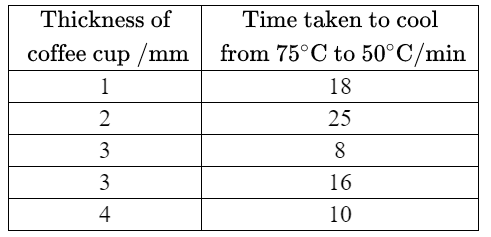IB myp 4-5 physics – Practice Questions- All Topics
Topic :Heat,Light and Sound-Thermal Physics
Topic :Heat,Light and Sound– Weightage : 21 %
All Questions for Topic : Thermal energy, conduction, convection, radiation, measuring temperature
Question (9 marks)
Another student, Gareth, finds that his cup of coffee cools down too quickly when taking it home from his local coffee shop. He wonders if the thin cardboard cup is the reason for the coffee cooling down too quickly.
Gareth formulates the hypothesis: “The thicker the coffee cup, the longer the coffee will take to cool down because the heat will take longer to transfer through the thicker material of the cup”. He finds cups of different thicknesses in his kitchen.
He fills each cup with coffee to the same level and times how long it takes for the coffee to cool down from $75^{\circ} \mathrm{C}$ to $50^{\circ} \mathrm{C}$ in each cup.

Question a (1 mark)

State and justify whether the results of Gareth’s investigation support his hypothesis.
▶️Answer/Explanation
Ans:
Question b (8 mark)
Identify four weaknesses in Gareth’s method. For each of the weaknesses, explain how his investigation was affected. Use scientific knowledge and understanding in your answer.
▶️Answer/Explanation
Ans:
Weakness 1: Lack of control over other variables
Explanation: Gareth’s investigation lacks control over other variables that can influence the cooling rate of the coffee. Factors such as the initial temperature of the coffee, the room temperature, and the surface area of the cups are not standardized. This lack of control makes it difficult to attribute the observed differences solely to the thickness of the cups.
Weakness 2: Inadequate sample size
Explanation: Gareth’s investigation only includes a limited number of cups with different thicknesses. A larger sample size would provide a more comprehensive representation of the relationship between cup thickness and cooling rate. With only a few data points, the conclusions drawn from the results may not be statistically significant or reliable.
Weakness 3: Lack of replication
Explanation: Gareth did not perform multiple trials for each cup thickness. Replicating the experiment multiple times would help assess the consistency and reliability of the results. It would also allow for a more accurate determination of the average time taken to cool down for each cup thickness.
Weakness 4: Lack of insulation control
Explanation: The investigation does not account for the potential influence of insulation properties of the cups. Different cups may have varying insulation capabilities, which could affect the cooling rate. To isolate the effect of thickness, Gareth should use cups made of the same material and with consistent insulation properties.
These weaknesses in Gareth’s method affect the validity and reliability of his investigation. Without controlling for other variables, increasing the sample size, replicating the experiment, and accounting for insulation properties, it becomes challenging to draw accurate conclusions about the relationship between cup thickness and cooling rate. The results may be influenced by confounding factors, leading to unreliable conclusions.
Question:
Which method of heat transfer (conduction, convection or radiation) is most likely to be responsible for:
a) heat flowing from the gas inside of the piston to the outside of the piston?
▶️Answer/Explanation
Ans: Conduction
b) heat energy leaving the outside of the piston?
▶️Answer/Explanation
Ans: Radiation